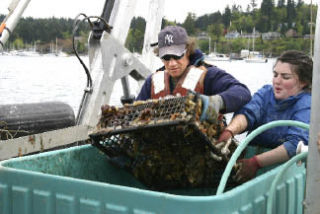Leaning over the gunwale of a skiff at Winslow Wharf on Monday, Cara Cruickshank guided a black buoy alongside and grasped a line dangling beneath it. The rope held suspended a sturdy cage just below the surface; but both line and cage were nearly invisible under a layer of harbor organisms including sponges, worms, algae, even sea urchins.
“Each of these lines becomes a reef full of life,” Cruickshank said, stripping away a clump of mussels that clung stubbornly to the rope. “It’s just incredible.”
Inside the cage is another bounty of life, a lumpy, thriving pile of Pacific oysters.
They are a few dozen of the 100,000 “Oysters for Salmon” that have been cultivated in baskets beneath harbor marinas for the last two years as part of a Natural Landscapes project, led by Cruickshank, and supported by the Puget Sound Restoration Fund and the city.
The oysters are being grown not for food, but rather for what they eat.
Oysters are voracious filter feeders that glean over-abundant algae, plankton and nutrients from the harbor’s water. Cruickshank and her partners believe the oysters can play a role in counteracting the sewage, fertilizers and other nutrients that are washed into the bay, feeding excessive growth, which robs oxygen from eelgrass and other organisms.
Each oyster is capable of filtering 55 gallons of water per day. Put together, the more than 500 baskets of oysters in the harbor are cycling through an estimated 5 million gallons of water daily. Oysters absorb nutrients into their bodies, depositing some waste onto the seafloor, where it can be used by aquatic plants, and outgassing some to the surface.
Well fed on algae blooms, the oysters have outgrown their cages, and this week are being transplanted to beaches along Eagle Harbor to continue filtering.
On Monday, Cruickshank, aided by Betsy Peabody and biologist Brian Allen of the Puget Sound Restoration Fund, along with volunteer Kaza Ansley began the arduous process of gathering the baskets from the marinas. At Queen City Marina, aboard a research vessel operated by Eric Parker, Allen and Ansley opened each slimy cage and dumped the oysters into a plastic fish tote.
Amid the mussels and algae Allen points out an unwanted pest. The gelatinous bodies of invasive tunicates – or sea squirts – have coated cages and oysters, and can suffocate surrounding organisms if allowed to grow unchecked.
Before the oysters can be released onto beaches they will be soaked in freshwater and scrubbed onshore to kill off potentially damaging species.
This weekend 50 students from Sakai Intermediate School and Bainbridge High School will descend on Eagle Harbor to help with the work and learn more about harbor ecosystems. Students have been an active part of the program helping to monitor and maintain the cages.
Education of both students and adults will be an important tool for preventing nutrient overloading, which is a problem both in Bainbridge waters and throughout Puget Sound, Cruickshank said.
This spring the city and Kitsap County Health District have been testing sources of runoff along several island coastlines for fecal coliform, a bacteria found in human and animal feces.
The study found fecal coliform levels that exceeded district standards at 20 percent of the 133 south-end sites tested and three faulty septic systems were identified.
City Water Resources Specialist Jalyn Cummings said three out of four surveying runs in Eagle Harbor have been completed, but so far fecal coliform levels there appear lower than other sampled shorelines.
“We found that it looks fairly good overall,” Cummings said.
Oysters for Salmon participants have been collecting there own nutrient data since the project began, measuring levels of nitrogen and phosphorous which can come from a variety of sources including fertilizers, septic and graywater.
“We kind of put our thumb to the pulse of Eagle Harbor for a year,” Allen said.
Perhaps their most significant finding, Allen said, was that spikes in nutrient levels corresponded with periods of heavy rain.
To Allen and Cruickshank it suggests that much of the nutrients in Eagle Harbor are washed in on stormwater from beyond the shoreline.
That means everyone on the island needs to be aware that fertilizers, chemicals and waste from faulty septic systems often ends up in a harbor or Puget Sound.
“Everything runs downhill,” Cruickshank said. “If they have a ditch, that runs off to somewhere, to somewhere, to somewhere and ends up in a harbor.”
This summer Cruickshank said she will be offering islanders workshops on maintaining septic systems and using environmentally friendly yard products.
Boats are another common source of nutrients. It is illegal for boats to discharge sewage and graywater into the sound rather than a designated pump-out station.
“That’s the rule, but no one seems to know it,” Cruickshank said.
Cruickshank stresses that it will take a combination of education, improved technology and implementation keep nutrient levels in check. The oysters will continue to do their small part, feasting on algae from their new homes on the beach.
“This is just one way of improving water quality,” Cruickshank said. “One small way.”
Box: Learn more about the Oysters for Salmon project at www.naturallandscapes.org.



